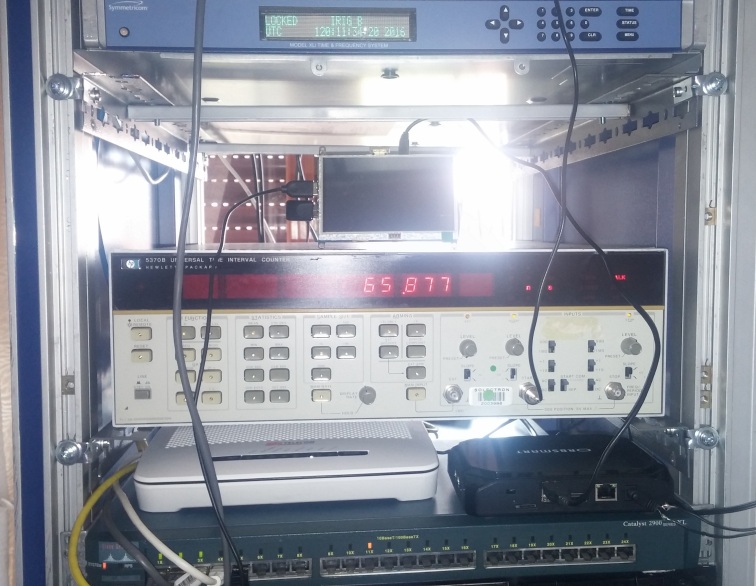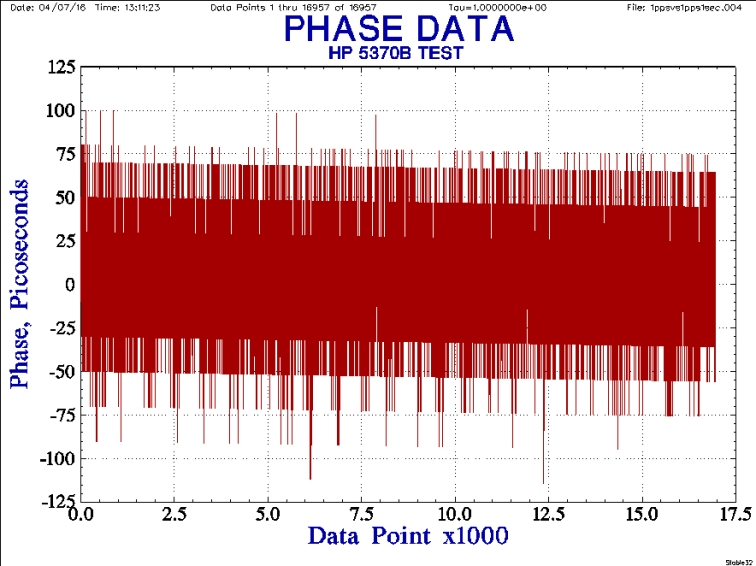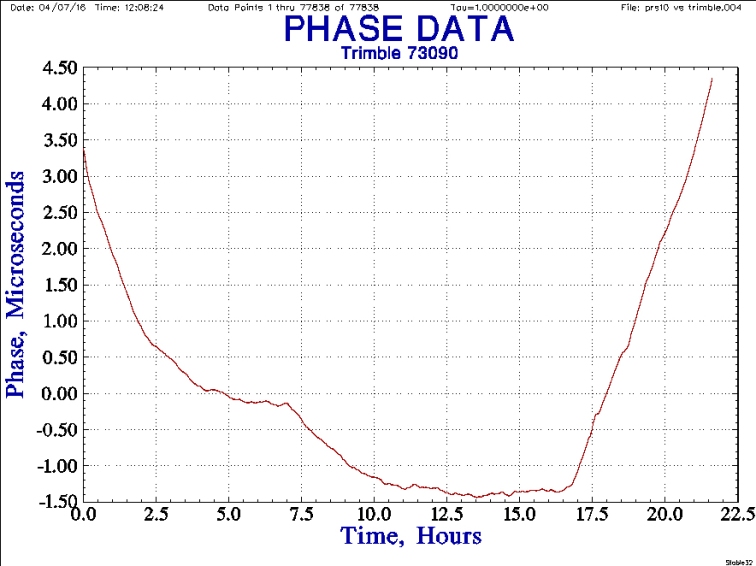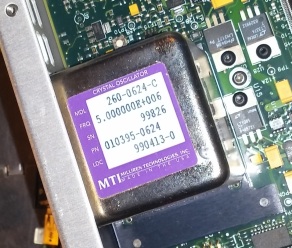
Time has come to make some measure and view the actual performance of some time and frequency standards that I’ve got here.In the market, there are many instruments that can perform this kind of job: frequency counters and time interval counters for example.
Since I can not afford instruments such as the Microsemi 5120a, A7-MXU etc.,(which can easily go down 10 picoseconds accuracy (!)) I found in a laboratory in Germany the HP 5370B, which boasts a T.I. (Time interval) resolution of about 20 picoseconds (HP Application Note ) I was lucky to find a really good one and, despite the years, well maintained too .
The unit comes with its internal oscillator : an HP 10811-60111 an OCVCXO ( oven-controlled voltage-controlled crystal oscillator ) it is also possible to use an external reference standard like a rubidium or a cesium (see later) . Since the internal computer in frequency counter mode it is a little old (’80…) , considering its age it is better to use this instrument as a time interval counter to achieve the maximum possible performances. The first question, as soon I’ve received the 5370B , was : how i can be sure that this unit is calibrated? So i decided to measure its accuracy using Febos’s method with a 1PPS from a Xli GPS receiver ( xli ). I have connected the same signal to the start and the stop triggers, measuring the time difference as soon the signal arrive to the start and leave it to the stop trigger as it exits from the coaxial cable (both of 20 meters ,with a interval of 51 ns) using 1 second sample size . I connected the unit to the PC to collect binary T.I. data (or phase) measurements using TimeLab software After normalizing data, filling gaps and drift errors i was able to plot the overall phase using Stable32 :


Despite some spikes of 60 picoseconds (probably due to the room temperature, or cable ?) the overall mean was around of 20 picoseconds. Luckily the unit seems to be calibrated and ready to perform some other measurements. To complete this test, i created a Modified Allan Deviation graph to plot the system stability in the time domain .

MTI 260 OCXO vs Trimble 73090 OCXO
I moved then to a first test between two OCXO’s : The MTI 260 ( Lucent KS-24361 HP/Symmetricom Z3809A, Z3810A, Z3811A, Z3812A low cost GPSDO system ) mounted on a Lucent KS-24361 (free running) and the highly acclaimed Trimble 73090 (free running too). You can find the second one on many cheap GPSDO on ebay.
For reference, i’ve used a Rb Oscillator connected to the HP 5370B, the PRS10 Rubidium Frequency Standard from Standford Research Systems . It was also connected to the 1PPS from a GPS receiver . Here is a screen example using Rb Mon to monitor the output from the PRS10 .
Both oscillators were up and running for 24 hours before the test. First the MTI 260 OCXO. As described from Milliren Technologies :
The 260 Series is an ultra high stability/high reliability oven controlled quartz crystal oscillator (OCXO). The 260 Series OCXO offers thermal stabilities from 2.0E-010 to 4.0E-009 over a 100oC temperature range, rivaling Rubidium atomic clock performance without the wear-out phenomena associated with Rubidium standards. The 260 Series OCXO has been used in many applications worldwide as a direct replacement for atomic clocks, providing a substantial cost savings both in the short and long term.
The premises are excellent. Indeed my Lucent it is always ON and just works very well disciplined by GPS too. ( gpsmonitor now offline ) . But what is the performance when this OCXO it’s in free run? Here are the results of 24 hours running , the PRS10 as reference using both 10MHz, one second sampling rate:


The overall results seem to be in line with the manufacturer’s specifications ( 260_MTI ) : at 10 seconds (short term stability) is about 4E-12 and after 24 hours at 5.91E-12 . This means less of 200 ns/day! Let’s see the Trimble instead :


As you can see there is an order of difference between those OCXO… The Trimble it is a medium performance OCXO : 5E-11 at 10 seconds and 6E-11 after 24 hours running. This means less than few microseconds in 24 hours. The MTI it is one order better than the Trimble . Here is the final graph using Miles’s TimeLab Software , plotting the MTI, the Trimble and the accuracy resolution of the HP 5370B (1PPS test)
Finally I’ve created two plots of the Dynamic Stability of both oscillators. It uses a sequence of sliding time windows to create an Allan analysis showing changes in clock behavior versus time. It is able to detect clock stability (noise burst, changes in noise etc.)that would be difficult to see in an ordinary overall stability analysis. ( see more )
MTI 260 DVAR :

Trimble 73090 DVAR:





Would you have the HP application note HP5370B-2 ? The link provided is dead.
Would very much appreciate this as I just got my hands on a decent 5370B
Regards
Len
LikeLike
Hi Len,
sorry could not find it a anymore.
I will search on my databases will let you know.
LikeLike
Thanks a lot ! Will eagerly await the result of your search 🙂
LikeLike
I found and uploaded again the pdf ,please try to click again on the application note link.
Kind Regards,
LikeLike
Thank you so much !! Would you have advise / hints for me on the subject of connecting the 5370B to a PC ?
I e a known working and commercially available adapter / software ?
Regards
Len
LikeLike
My pleasure. Sure!
It’s pretty easy. Buy a GPIB-USB converter like this one https://www.sparkfun.com/products/549
Use a free software like Timelab ( https://www.sparkfun.com/products/549 ) .
Connect the cable to your pc (installing the GPIB drivers and be sure they are recognized ) .
In Timelab , go to Acquire –> HP5370A/B . You will see the virtual COM port that should has been created by the GPIB device, also previewing the actual HW readings.
From that moment , you can do whatever you want, will just about measuring.
LikeLike
Once again: Thank you so much ! as I understand, Timelab has the advantage over Stable32 that it allows preview of data during load/collection. Would be more helpful if I got that right…
Regards / Len
LikeLiked by 1 person
They both complete each other. Best is of course use them together . I think for linear phase is better Stable32 . Also you can do more detailed analysis . If you need , I created a program from Unix/Linux that take the same exact formula from Stable32 and re-create the the linear phase for live analysis if you have an ASCII file . ( https://deltafabri.wordpress.com/2017/04/30/creating-phase-from-frequency-using-python-and-allantools/ )Timelab is a great tool for any kind of use .
LikeLike